Best Tech Support So Far.
So I got to Mexico and my 3G connection did not work, so I repeated the European steps and called Cingular Tech Support to complain that something was wrong with my 3G card in Mexico.
Since neither the 2g or 3g lights turned on and this was working in Boston and Washington, it must have been some configuration issue on Cingular's side.
I explained to the tech guy my situation, and he walked me through the usual "connection manager", "try a different setting", "eject your card", and so forth and I pretended to do the Windows steps with the equivalent Linux command as far as I could.
My goal in this call was to avoid saying that I was using Linux, I feared they would just say "Sorry, we dont support that" and hang up.
There was the dangerous "What does the connection manager say?", to which I replied "Mhm, no network". And "What version of it you have?" to which I replied "Well, I use the equivalent, its called yast".
But then the fatal, "Which version of Windows is this?" to which I had to say "Linux".
Contrary to what I expected, he said "Can you configure the AT commands or enter them?", I said I could, I launched minicom and he walked me through the process of configuring the Sierra card (probing for providers, selecting the provider, reseting the card).
He determined during the call that there was a setup problem with Mexico's provider, he was able to patch that stuff on their end and got me going with a 2g connection after a little while.
Many thanks to Mr Robinson in tech support over at at&t
Posted on 01 Mar 2007
Covert Operations in Iran
On Februrary 16th, in an interview with Noam Chomsky, the interview is one of Chomsky's best.
At one point he speculates about the potential strategy being applied to Iran:
[...] So it could be that one strain of the policy is to stir up secessionist movements, particularly in the oil rich regions, the Arab regions near the Gulf, also the Azeri regions and others. Second is to try to get the leadership to be as brutal and harsh and repressive as possible, to stir up internal disorder and maybe resistance. And a third is to try to pressure other countries, and Europe is the most amenable, to join efforts to strangle Iran economically. Europe is kind of dragging its feet but they usually go along with the United States.
This week Seymour Hersh publishes
on the New Yorker some of his findings. The article makes
the case that the US is now funding
terroristsfreedom fighters in Iran to
destabilize the regime (as speculated by Chomsky before).
The article also happens to match some of Chomsky's
observations.
For a quick overview you can watch this video interview with Seymour Hersh.
Chomsky:
It’s very hard to predict the Bush administration today because they’re deeply irrational. They were irrational to start with but now they’re desperate. They have created an unimaginable catastrophe in Iraq. This should’ve been one of the easiest military occupations in history and they succeeded in turning it into one of the worst military disasters in history. They can’t control it and it’s almost impossible for them to get out for reasons you can’t discuss in the United States because to discuss the reasons why they can’t get out would be to concede the reasons why they invaded.
If you listen to Seymour's interview it seems that the strategy is going from "unimaginable catastrophe in Iraq" to "unimaginable catastrophe in the whole Middle East".
In the meantime, it turns out that the weapons that were presented a couple of weeks ago as being "manufactured in Iran" turned out to be manufactured in Iraq.
If that was not enough, the UN Calls US Data on Iran's Nuclear Aims Unreliable:
The officials said the CIA and other Western spy services had provided sensitive information to the Vienna-based International Atomic Energy Agency at least since 2002, when Iran's long-secret nuclear program was exposed. But none of the tips about supposed secret weapons sites provided clear evidence that the Islamic Republic was developing illicit weapons."Since 2002, pretty much all the intelligence that's come to us has proved to be wrong," a senior diplomat at the IAEA said. Another official here described the agency's intelligence stream as "very cold now" because "so little panned out."
For those of us too cynical to believe anything the Bush administration has to say on any matter, this is hardly news. But it is always nice to see them debunked in public.
Posted on 27 Feb 2007
Getting Ripped Off: A Consolidation Strategy
Last week I described how international travel for an Internet addict can be very costly, 10 euros here, 12 dollars there 20 euros for 24 hours there and very soon you have paid a hundred dollars in a two-day trip on Internet access fees.
Now, instead of paying half a dozen people to get WiFi access, I have consolidated my "getting ripped off" with AT&T. Now they bill me an insane amount for getting "3G worldwide access".
Two problems though: "3G worldwide" actually means "3G in Boston, and 9600 baud modem speed in Europe". During the entire trip I could not get the "3G" light on the card to turn on, it consistently stayed in "2G" mode.
But just before you think "Well, GPRS/2G is not so bad", I want to point out that it took 25 seconds to load www.google.com.
Posted on 27 Feb 2007
Usability Interview with Anna Dirks
 Ted Haeger interviews
Anna Dirks.
Ted Haeger interviews
Anna Dirks.
Anna leads the team at Novell that was in charge of improving the usability of the desktop. Her team launched Better Desktop, the Tango Icons and prototyped, tuned, improved, mocked-up and tested various elements of the usability elements in the SLED desktop.
Her interview is here in Novell's Open Audio.
She talks about the process used to design the new features of SLED and it also got a few hints on what is coming up for SLED 10 SP1 (pay attention to the physical weight of the Usability Labs).
Posted on 26 Feb 2007
Feedback requested: FOSDEM Conference
 This weekend am heading to Brussels to the FOSDEM conference. The
last time I spoke there, Mono was in its infancy (2002). At
the time the C# was about to be self-hosting on Linux, but was
not quite there (0.8
and 0.9
releases).
This weekend am heading to Brussels to the FOSDEM conference. The
last time I spoke there, Mono was in its infancy (2002). At
the time the C# was about to be self-hosting on Linux, but was
not quite there (0.8
and 0.9
releases).
Now, five years later Mono has gone through 60 releases and is made up of a few million lines of code and has spawned plenty of software projects.
The question is: What kind of things should I talk about in my two sessions at FOSDEM?
I have one general Mono session, and one session in the OpenSUSE track. Since Mono is so large, and there are so many interesting things being done with it, I find it challenging to find a good topic to discuss with a technical audience like FOSDEM.
I could do a general overview and give some high-level overview of what we are doing, but I feel that the FOSDEM audience is probably more interested in something more technical. So I should probably limit my presentations to two or three key topics.
Should I talk about what is available today, and what are people doing today, or should I talk about the future, and what we want to do?
Maybe the general session could be about the state of the project and where we want to go in the future; And the OpenSUSE session about the practical things that can be done today. Not sure.
What would you like to hear about?
Posted on 21 Feb 2007
Reflector 5.0
Lutz Roeder has just released a new version of Reflector:
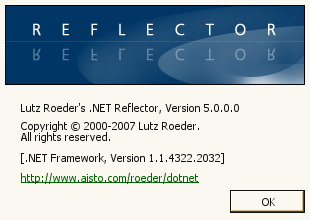
This time Reflector will work out of the box with Mono on Unix (no special handling or special flags) and will even detect the presence of your Mono libraries:
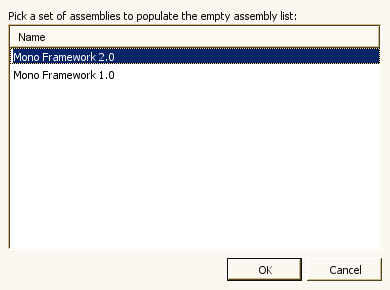
Recently, while implementing the second chunk of lambda expressions, I had to go through all the classes that derived from the Mono.CSharp.Expression and the Mono.CSharp.Statement classes to implement the "CloneTo" methods, and Reflector came in as a great tool to find those classes with minimal fuzz and without wasting any grep batteries in the process:
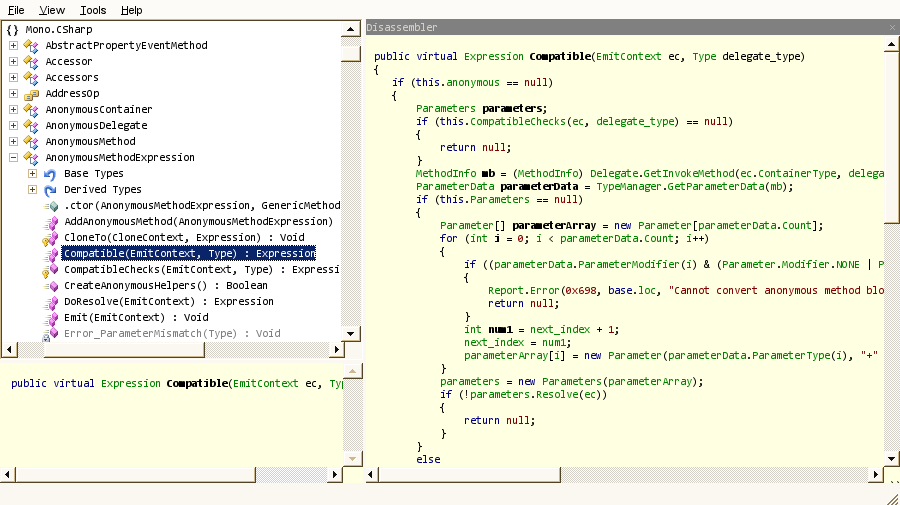
Reminder: the use of Reflector to look at third-party code is prohibited if you are planning on ever contributing to Mono. You are free to use Reflector to decompile Mono code though.
I would have blogged early this morning when the news came out, but I struggled betwen Consolas, Monaco and Tahoma for the screenshot. Solving the dilemma was only possible thanks to the extensive dinner discussion with Garrett and Jeff at Kashmir.
One great feature is the Reflector Analyzer to explore who exposes, uses, depends or inherits a given type:
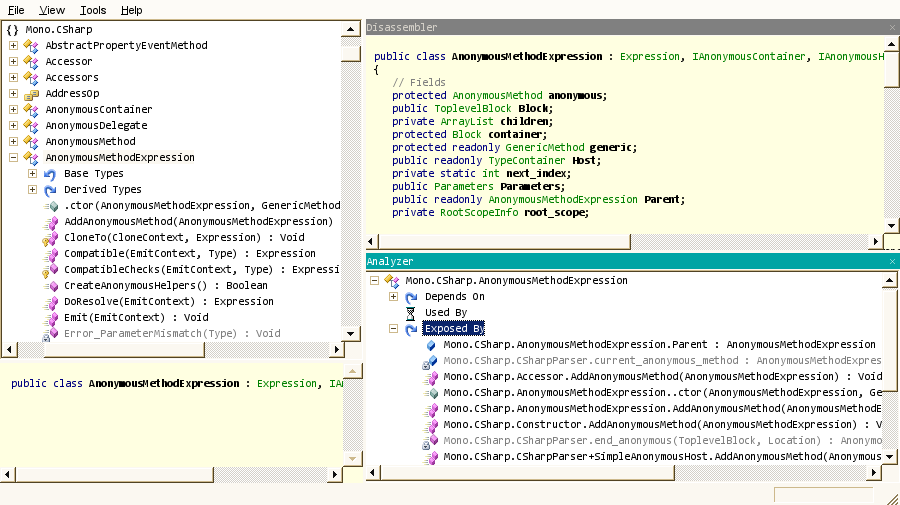
There are no borders on the screenshots due to the way Compiz paints windows on the screen (a separate process paints the decorations).
Jackson has been fixing various issues in Winforms to improve the rendering. These screenshots are the result of his endless hours of work. Thanks Jackson!
Posted on 21 Feb 2007
Sierra Aircard 875, Cingular and SUSE Linux
 After being ripped off by hotels and airports for my
Internet connections (with some places charging as much as 20
euros per hour, and your standard 10 euro per hour at CDG), I
have purchased a 3G card from Cingular and a plan to use it
internationally.
After being ripped off by hotels and airports for my
Internet connections (with some places charging as much as 20
euros per hour, and your standard 10 euro per hour at CDG), I
have purchased a 3G card from Cingular and a plan to use it
internationally.
I followed the instructions on this blog post that covers another card on OpenSUSE 10.2.
With SLED 10 and the Aircard 875, the only difference is that I had to use a different vendor and product ID:
# /sbin/modprobe usbserial vendor=0x1199 product=0x6820
Or alternatively dump that in the /etc/udev/rules.d/51-3g-datacards.rules file.
Once you configure the modem in yast as described in the above blog post, go to NetworkManager, and select the "modem0" serial connection. There seems to be a bug in NetworkManager, when the modem0 connection is active, the icon seems to go away (am guessing its not finding the icon for it, and hence the applet vanishes).
A few minutes later, you will be online.
Am still missing some tools to determine the upload/download speed, anyone have some good pointers?
Posted on 21 Feb 2007
Visual Basic Love
Today we announced the support of Visual Basic.NET in Mono.
Visual Basic is still one of the most used languages in the Windows world, and with this release we hope to assist a large segment of the population to bring those applications to Unix with Mono.
Rolf developed the new compiler. The new compiler is fascinating because it is a VB 8 compiler (this means that it supports generics), but also because it is written in VB itself. This compiler was sponsored last summer by the Google Summer of Code (2006 edition).
The compiler on my laptop takes 12 seconds to compile itself (78,000 lines of code).
The new runtime (for 1.0 and 2.0) was developed by Boris Kirzner, Guy Cohen and Rafael Mizrahi at Mainsoft and just like the VB compiler it was written in VB, and it is made up of roughly 17,000 lines of code.
As some people have pointed out, the compiler and the runtime are not enough to run applications. A lot of the portability will be mandated by your API consumption. If your application is based on .NET 1.0, you should be ready to use Mono now. If you are using .NET 2.0, you will need to check whether everything your application needs is supported by using Moma the Mono Migration Analyzer.
Our 2.0 support these days for ASP.NET and the core is passable. It is not 100% there, but the ASP.NET Starter Kits should run, and so should applications like mojoPortal.
Posted on 20 Feb 2007
My Name
I was reading Rolf's post where he complains that people never get his name right. I am used to it.
English speakers typically pronounce my name as "Mi-koo-elle", or "Mi-goo-elle", while the actual pronunciation is more like "Mig-elle".
Bonus Update: Also most English speaking people miss-pronounce "de Icaza" as "di-eye-kaza", but it is pronounced "the-eekaza".
Posted on 20 Feb 2007
Updated Main Menu
Ted Haeger discusses the changes done recently to the Main Menu. Link to the video:
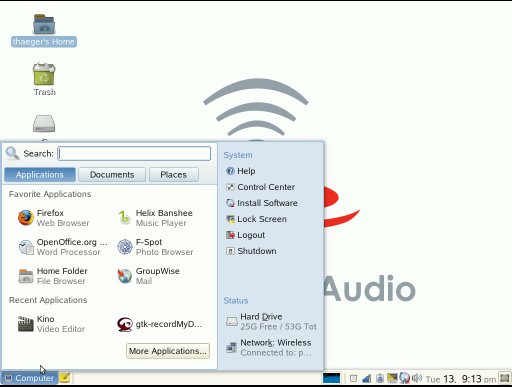
I love the main menu that Anna's team designed and Jimmy implemented. The KDE folks then improved upon the design and on this new iteration some of the ideas from the KDE design are incorporated.
The code is available from Gnome's SVN
Update: Someone at the office told me story of how the "Search" input box at the top of the main menu ended up at there.
In the early days of the main menu the search bar was at the bottom of the main menu, similar in spirit to Vista, but this prototype existed before Vista integrated it.
Garrett created a "Gnome Desktop" with HTML and Javascript a few months back, and they used this HTML-based desktop to quickly try out many ideas with different people.
During the routine usability tests that are conducted in the Cambridge office, one of the tasks that was part of the test was something along the lines of "Find the document that contains foo". But people would not use the built-in search, they did not notice it on the main menu. Instead people went to the file manager and started opening file by file to find the document.
When the search was moved to the top, the subjects in the usability tests immediately started using it.
Then Vista released their first menu with search integrated at the bottom of the menu. I have been wondering if the guys in the Vista team had conducted any similar tests with their start menu.
Joel posted a few months ago his complains about the logoff functionality in the Vista menu. The developer involved in implementing that bit for Vista then blogged about it and followed up here:
Then someone from the MacOS team weighted in and described the process used at Apple.
From Ted Haeger's video you can see that logout/shutdown also got redesigned with the new menu. I do not know the story behind how it got implemented (there are now two options: shutdown/logoff in the menu) and both bring up two dialogs with further options.
It would be interesting from someone on the Novell Desktop team to blog about that process to complement the Vista and OSX postings.
Posted on 18 Feb 2007
« Newer entries | Older entries »
Blog Search
Archive
- 2024
Apr Jun - 2020
Mar Aug Sep - 2018
Jan Feb Apr May Dec - 2016
Jan Feb Jul Sep - 2014
Jan Apr May Jul Aug Sep Oct Nov Dec - 2012
Feb Mar Apr Aug Sep Oct Nov - 2010
Jan Feb Mar Apr May Jun Jul Aug Sep Oct Nov Dec - 2008
Jan Feb Mar Apr May Jun Jul Aug Sep Oct Nov Dec - 2006
Jan Feb Mar Apr May Jun Jul Aug Sep Oct Nov Dec - 2004
Jan Feb Mar Apr May Jun Jul Aug Sep Oct Nov Dec - 2002
Jan Feb Mar Apr May Jun Jul Aug Sep Oct Dec
- 2022
Apr - 2019
Mar Apr - 2017
Jan Nov Dec - 2015
Jan Jul Aug Sep Oct Dec - 2013
Feb Mar Apr Jun Aug Oct - 2011
Jan Feb Mar Apr May Jun Jul Aug Sep Oct Nov Dec - 2009
Jan Feb Mar Apr May Jun Jul Aug Sep Oct Nov Dec - 2007
Jan Feb Mar Apr May Jun Jul Aug Sep Oct Nov Dec - 2005
Jan Feb Mar Apr May Jun Jul Aug Sep Oct Nov Dec - 2003
Jan Feb Mar Apr Jun Jul Aug Sep Oct Nov Dec - 2001
Apr May Jun Jul Aug Sep Oct Nov Dec